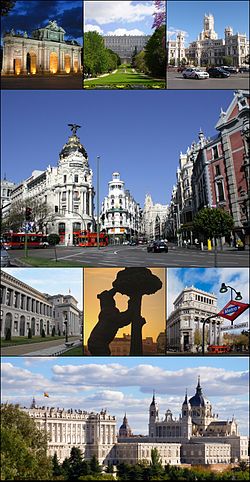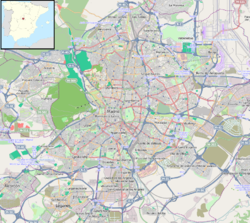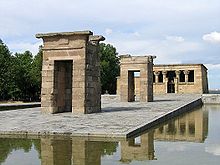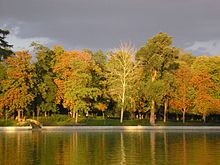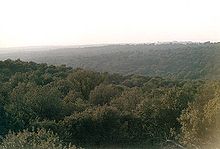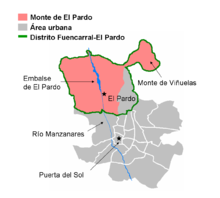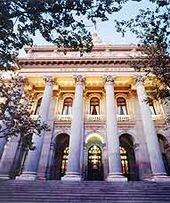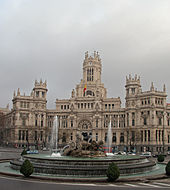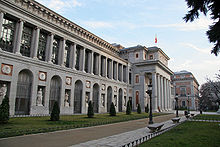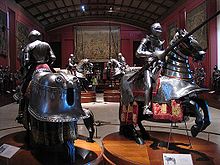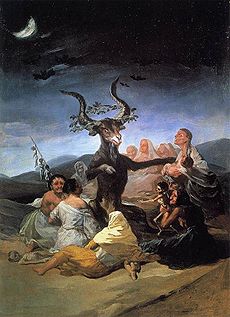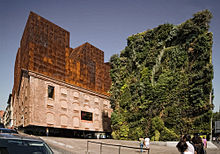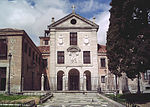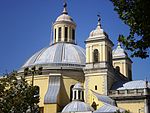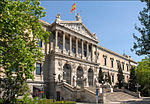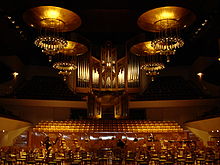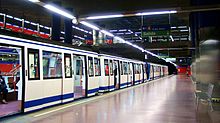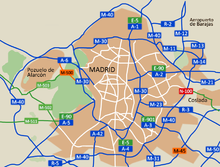- Madrid
-
This article is about the capital of Spain. For the Community of Madrid, see Madrid (autonomous community). For other uses, see Madrid (disambiguation).
Madrid Villa de Madrid 
Flag
Coat of armsMotto: «Fui sobre agua edificada,
mis muros de fuego son.
Esta es mi insignia y blasón»
("On water I was built,
my walls are made of fire.
This is my ensign and escutcheon")[1][2]Location of Madrid within Spain Map of Madrid Coordinates: 40°23′N 3°43′W / 40.383°N 3.717°W Country Spain Region Community of Madrid Founded IX Century[3] Government - Type Mayor-council - Body Ayuntamiento de Madrid - Mayor Alberto Ruiz-Gallardón (PP) Area - Land 607 km2 (234.4 sq mi) - Metro 10,506 km2 (4,057 sq mi) Elevation 667 m (2,188 ft) Population (2010) - City 3,273,049 - Rank 1st - Density 5,403/km2 (13,993.7/sq mi) - Metro 6,458,684 Demonym Madrilenian
madrileño (m) madrileña (f)
matritenseTime zone CET (UTC+1) - Summer (DST) CEST (UTC+2) Postal code 28001–28080 Area code(s) 34 (Spain) + 91 (Madrid) Patron Saints Isidore the Laborer
Virgin of AlmudenaWebsite www.munimadrid.es Madrid (/məˈdrɪd/, Spanish: [maˈðɾið]) is the capital and largest city of Spain. The population of the city is roughly 3.3 million[4] and the entire population of the Madrid metropolitan area is calculated to be 6.271 million.[5] It is the third largest city in the European Union, after London and Berlin, and its metropolitan area is the third largest in the European Union after London and Paris.[6][7][8][9] The city spans a total of 604.3 km2 (233.3 sq mi).[10]
Madrid urban agglomeration has the 3rd largest GDP[11] in the European Union and its influences in politics, education, entertainment, environment, media, fashion, science, and the arts all contribute to its status as one of the world's major global cities.[12][13] Due to its economic output, high standard of living, and market size, Madrid is considered the major financial centre of Southern Europe[14][15] and the Iberian Peninsula; it hosts the head offices of the vast majority of the major Spanish companies. Madrid is the most touristic city of Spain, the fourth-most touristic of the continent,[16] and is the 10th most livable city in the world according to Monocle magazine, in its 2010 index.[17][18] Madrid also ranks among the 12 greenest European cities in 2010.[19] Madrid is currently bidding to host the 2020 Summer Olympics.[20]
The city is located on the Manzanares river in the centre of both the country and the Community of Madrid (which comprises the city of Madrid, its conurbation and extended suburbs and villages); this community is bordered by the autonomous communities of Castile and León and Castile-La Mancha. As the capital city of Spain, seat of government, and residence of the Spanish monarch, Madrid is also the political centre of Spain.[21] The current mayor is Alberto Ruiz-Gallardón from the People's Party (PP).
While Madrid possesses a modern infrastructure; it has preserved the look and feel of many of its historic neighbourhoods and streets. Its landmarks include the Royal Palace of Madrid; the Teatro Real (Royal theatre) with its restored 1850 Opera House; the Buen Retiro park, founded in 1631; the 19th-century National Library building (founded in 1712) containing some of Spain's historical archives; an archaeological museum; and the Golden Triangle of Art, located along the Paseo del Prado and comprising three art museums: Prado Museum, the Museo Nacional Centro de Arte Reina Sofía, a museum of modern art, and the Thyssen-Bornemisza Museum, housed in the renovated Villahermosa Palace.[22]
Toponym
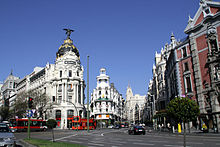 Alcalá Street and the Metropolis Building
Alcalá Street and the Metropolis Building
There are several theories regarding the origin of the name "Madrid". According to legend Madrid was founded by Ocno Bianor (son of King Tyrrhenius of Tuscany and Mantua) and was named "Metragirta" or "Mantua Carpetana". Others contend that the original name of the city was "Ursaria" ("land of bears" in Latin), due to the high number of these animals that were found in the adjacent forests, which, together with the strawberry tree (Spanish: madroño), have been the emblem of the city from the Middle Ages.[3]
The most ancient recorded name of the city Magerit (for *Materit or *Mageterit ?) comes from the name of a fortress built on the Manzanares River in the 9th century AD, and means "Place of abundant water".[23] If the form is correct, it could be a Celtic place-name from ritu- 'ford' (Old Welsh rit, Welsh rhyd, Old Breton rit, Old Northern French roy) and a first element, that is not clearly identified *mageto derivation of magos 'field' 'plain' (Old Irish mag 'field', Breton ma 'place'), or matu 'bear", that could explain the Latin translation Ursalia.[24]
Nevertheless, it is now commonly believed[citation needed] that the origin of the current name of the city comes from the 2nd century BC. The Roman Empire established a settlement on the banks of the Manzanares river. The name of this first village was "Matrice" (a reference to the river that crossed the settlement). Following the invasions carried out by the Germanic Sueves and Vandals, as well as the Sarmatic Alans during the 5th century AD, the Roman Empire no longer had the military presence required to defend its territories on the Iberian Peninsula, and as a consequence, these territories were soon overrun by the Visigoths. The barbarian tribes subsequently took control of "Matrice". In the 7th century, the Islamic conquest of the Iberian Peninsula saw the name changed to "Mayrit", from the Arabic term ميرا "Mayra" (referencing water as a "trees" or "giver of life") and the Ibero-Roman suffix "it" that means "place". The modern "Madrid" evolved from the Mozarabic "Matrit", which is still in the Madrilenian gentilic.[25]
History
Main article: History of MadridMiddle Ages
Although the site of modern-day Madrid has been occupied since pre-historic times,[26] in the Roman era this territory belonged to the diocese of Complutum (present-day Alcalá de Henares). There are archeological remains of a small village during the visigoth epoch, whose name might have been adopted later by Arabs.[3] The origins of the modern city come from the 9th century, when Muhammad I ordered the construction of a small palace in the same place that is today occupied by the Palacio Real. Around this palace a small citadel, al-Mudaina, was built. The citadel was conquered in 1085 by Christian king Alfonso VI of Leon and Castile in his advance towards Toledo. He reconsecrated the mosque as the church of the Virgin of Almudena (almudin, the garrison's granary). In 1329, the Cortes Generales first assembled in the city to advise Alfonso XI of Castile. Sephardi Jews and Moors continued to live in the city until they were expelled at the end of the 15th century.[3] After troubles and a large fire, Henry III of Castile (1379–1406) rebuilt the city and established himself safely fortified outside its walls in El Pardo.
The grand entry of Ferdinand and Isabella to Madrid heralded the end of strife between Castile and Aragon,[3] and the beginning of the influence of the Renaissance in Spain.
Modern Age
The Crown of Castile, with its capital at Toledo, and the Crown of Aragon, with its capital at Zaragoza, were welded into modern Spain by the Catholic Monarchs (Queen Isabella of Castile and King Ferdinand II of Aragon).[3] Though their grandson Charles I of Spain (also known as Charles V, Holy Roman Emperor) favoured Seville, it was Charles' son, Philip II (1527–1598) who moved the court to Madrid in 1561. Although he made no official declaration, the seat of the court was the de facto capital. Seville continued to control commerce with Spain's colonies, but Madrid controlled Seville.[27]
Aside from a brief period, 1601–1606, when Felipe III installed his court in Valladolid, Madrid's fortunes have closely mirrored those of Spain.
During the Siglo de Oro (Golden Century), in the 16th/17th century, Madrid knew its ultimate glory; El Escorial, the great royal monastery built by King Philip II of Spain, invited the attention of some of Europe's greatest architects and painters. Diego Velázquez (painter of Las Meninas and The Surrender of Breda), regarded as one of the most influential painters of European history and a greatly respected artist in his own time, cultivated a relationship with King Philip IV and his chief minister, the Count-Duke of Olivares, leaving us several portraits that demonstrate his style and skill. El Greco, another respected artist from the period, infused Spanish art with the styles of the Italian renaissance and helped create a uniquely Spanish style of painting.
Madrid was one of the cultural centres during the Spanish Golden Century. The Spanish court attracted many top Spanish artists and writers to the city, including Miguel de Cervantes (author of Don Quixote de la Mancha) and the aforementioned Diego Velázquez. Furthermore, in the city were born many of the great writers of this period: Lope de Vega, Francisco de Quevedo, Calderon de la Barca and Tirso de Molina, and the last of the great painters of the Golden Age, Claudio Coello. The renowned Renaissance architect Juan de Herrera designed the Plaza Mayor, which was built in the city during the Habsburg period as a central plaza. It is located near another famous plaza, the Puerta del Sol.
New palaces (including the Palacio Real de Madrid) were built during Philip V´s reign. However, it would not be until Charles III (1716–1788) that Madrid would become a modern city. Charles III was one of the most popular kings in the history of Madrid, and the saying "the best mayor, the king" became popular during those times. When Charles IV (1748–1819) became king the people of Madrid revolted. After the Mutiny of Aranjuez, which was led by his own son Ferdinand VII against him, Charles IV resigned, but Ferdinand VII's reign would be short: in May 1808 Napoleon's troops entered the city.
From 19th century to present day
On the second of May (Spanish: Dos de Mayo), 1808, the people of Madrid rebelled against the occupation of the city by French troops, provoking a repression by the French Imperial forces and triggering the Spanish War of Independence.
After the war of independence (1814) Ferdinand VII came back to the throne, but after a liberal military revolution, Rafael del Riego made the king swear respect to the Constitution. This would start a period where liberal and conservative government alternated, that would end with the enthronement of Isabellla II (1830–1904). She could not suppress the political tension that would lead to yet another revolt, the First Spanish Republic. This was later followed by the return of the monarchy to Madrid, then the creation of the Second Spanish Republic, preceding the Spanish Civil War.[27]
Madrid was one of the most heavily affected cities of Spain in the Civil War (1936–1939). The city was a stronghold of the Republicans from July 1936. Its western suburbs were the scene of an all-out battle in November 1936 and it was during the Civil War that Madrid became the first European city to be bombed by airplanes (Japan was the first to bomb civilians in world history, at Shanghai in 1932) specifically targeting civilians in the history of warfare. (See Siege of Madrid (1936–39)).[27]
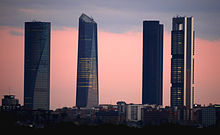 CTBA skyscrapers
CTBA skyscrapers
During the economic boom in Spain from 1959 to 1973, the city experienced unprecedented, extraordinary development in terms of population and wealth, becoming the largest GDP city in Spain, and ranking third in Western Europe. The municipality is extended, annexing neighbouring council districts, to achieve the present extension of 607 km2 (234.36 sq mi). The south of Madrid became very industrialized, and there were massive migrations from rural areas of Spain into the city. Madrid's newly built north-western districts became the home of the new thriving middle class that appeared as result of the 1960s Spanish economic boom, while south-eastern periphery became an extensive working class settlement, which was the base for an active cultural and political reform.[27]
After the death of Franco, emerging democratic parties (including those of left-wing and republican ideology) accepted King Juan Carlos I as both Franco's successor and as the heir of the historic dynasty – in order to secure stability and democracy. This led Spain to its current position as a constitutional monarchy, with Madrid as capital.[27]
Benefiting from increasing prosperity in the 1980s and 1990s, the capital city of Spain has consolidated its position as an important economic, cultural, industrial, educational, and technological centre on the European continent.[27]
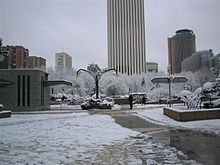 AZCA area on a winter day
AZCA area on a winter day
Climate
The Madrid region features a Continental Mediterranean climate[28] (Köppen Csa)[29] with cold winters due to altitude (650 m (2,133 ft) above sea level in Alicante), including sporadic snowfalls and minimum temperatures often below freezing. Summer tends to be hot with temperatures that consistently surpass 30 °C (86 °F) in July and August and rarely above 40 °C (104 °F). Due to Madrid's altitude and dry climate, diurnal ranges are often significant during the summer. Precipitation is concentrated in the autumn and spring. It is particularly sparse during the summer, taking the form of one or two showers and/or thunderstorms a month.
Climate data for Madrid, Parque del Retiro in the city centre Month Jan Feb Mar Apr May Jun Jul Aug Sep Oct Nov Dec Year Average high °C (°F) 9.7
(49.5)12.0
(53.6)15.7
(60.3)17.5
(63.5)21.4
(70.5)26.9
(80.4)31.2
(88.2)30.7
(87.3)26.0
(78.8)19.0
(66.2)13.4
(56.1)10.1
(50.2)19.4 Daily mean °C (°F) 6.2
(43.2)7.9
(46.2)10.7
(51.3)12.4
(54.3)16.1
(61.0)21.0
(69.8)24.8
(76.6)24.5
(76.1)20.5
(68.9)14.6
(58.3)9.7
(49.5)7.0
(44.6)14.6 Average low °C (°F) 2.6
(36.7)3.7
(38.7)5.6
(42.1)7.2
(45.0)10.7
(51.3)15.1
(59.2)18.4
(65.1)18.2
(64.8)15.0
(59.0)10.2
(50.4)6.0
(42.8)3.8
(38.8)9.7 Precipitation mm (inches) 37
(1.46)35
(1.38)26
(1.02)47
(1.85)52
(2.05)25
(0.98)15
(0.59)10
(0.39)28
(1.1)49
(1.93)56
(2.2)56
(2.2)436
(17.17)Avg. precipitation days (≥ 1 mm) 6 6 5 7 8 4 2 2 3 6 6 7 63 Sunshine hours 148 157 214 231 272 310 359 335 261 198 157 124 2,769 Source: Agencia Estatal de Meteorología[30] Climate data for Madrid-Barajas Airport, 9 km (5.59 mi) from the city's financial district Month Jan Feb Mar Apr May Jun Jul Aug Sep Oct Nov Dec Year Average high °C (°F) 10.6
(51.1)12.9
(55.2)16.3
(61.3)18.0
(64.4)22.3
(72.1)28.2
(82.8)33.0
(91.4)32.4
(90.3)27.6
(81.7)20.6
(69.1)14.7
(58.5)11.0
(51.8)20.6 Daily mean °C (°F) 5.4
(41.7)7.2
(45.0)9.8
(49.6)11.7
(53.1)15.6
(60.1)20.7
(69.3)24.5
(76.1)24.2
(75.6)20.2
(68.4)14.4
(57.9)9.2
(48.6)6.4
(43.5)14.1 Average low °C (°F) 0.3
(32.5)1.5
(34.7)3.2
(37.8)5.4
(41.7)8.4
(47.1)13.0
(55.4)16.1
(61.0)16.0
(60.8)12.7
(54.9)8.3
(46.9)3.8
(38.8)1.8
(35.2)7.6 Precipitation mm (inches) 33
(1.3)34
(1.34)23
(0.91)39
(1.54)47
(1.85)26
(1.02)11
(0.43)12
(0.47)24
(0.94)39
(1.54)48
(1.89)48
(1.89)386
(15.2)Avg. precipitation days (≥ 1 mm) 6 5 4 6 7 4 2 2 3 6 6 7 58 Sunshine hours 140 164 221 219 256 299 344 328 252 198 155 115 2,658 Source: Agencia Estatal de Meteorología[31] Water supply
Madrid derives almost 75 percent of its water supply from dams and reservoirs built on the Lozoya River, such as the El Atazar Dam.
Districts
Main article: Districts of MadridMadrid is administratively divided into 21 districts, which are further subdivided into 128 wards (barrios)
Madrid districts. The numbers correspond with the list in the left - Centro: Palacio, Embajadores, Cortes, Justicia, Universidad, Sol.
- Arganzuela: Imperial, Acacias, La Chopera, Legazpi, Delicias, Palos de Moguer, Atocha.
- Retiro: Pacífico, Adelfas, Estrella, Ibiza, Jerónimos, Niño Jesús.
- Salamanca: Recoletos, Goya, Parque de las Avenidas, Fuente del Berro, Guindalera, Lista, Castellana.
- Chamartín: El Viso, Prosperidad, Ciudad Jardín, Hispanoamérica, Nueva España, Castilla.
- Tetuán: Bellas Vistas, Cuatro Caminos, Castillejos, Almenara, Valdeacederas, Berruguete.
- Chamberí: Gaztambide, Arapiles, Trafalgar, Almagro, Vallehermoso, Ríos Rosas.
- Fuencarral-El Pardo: El Pardo, Fuentelarreina, Peñagrande, Barrio del Pilar, La Paz, Valverde, Mirasierra, El Goloso.
- Moncloa-Aravaca: Casa de Campo, Argüelles, Ciudad Universitaria, Valdezarza, Valdemarín, El Plantío, Aravaca.
- Latina: Los Cármenes, Puerta del Ángel, Lucero, Aluche, Las Águilas, Campamento, Cuatro Vientos.
- Carabanchel: Comillas, Opañel, San Isidro, Vista Alegre, Puerta Bonita, Buenavista, Abrantes.
- Usera: Orcasitas, Orcasur, San Fermín, Almendrales, Moscardó, Zofío, Pradolongo.
- Puente de Vallecas: Entrevías, San Diego, Palomeras Bajas, Palomeras Sureste, Portazgo, Numancia.
- Moratalaz: Pavones, Horcajo, Marroquina, Media Legua, Fontarrón, Vinateros.
- Ciudad Lineal: Ventas, Pueblo Nuevo, Quintana, La Concepción, San Pascual, San Juan Bautista, Colina, Atalaya, Costillares.
- Hortaleza: Palomas, Valdefuentes, Canillas, Pinar del Rey, Apóstol Santiago, Piovera.
- Villaverde: San Andrés, San Cristóbal, Butarque, Los Rosales, Los Ángeles.
- Villa de Vallecas: Casco Histórico de Vallecas, Santa Eugenia.
- Vicálvaro: Casco Histórico de Vicálvaro, Ambroz.
- San Blas: Simancas, Hellín, Amposta, Arcos, Rosas, Rejas, Canillejas, Salvador.
- Barajas: Alameda de Osuna, Aeropuerto, Casco Histórico de Barajas, Timón, Corralejos.
Metropolitan area
Main article: Madrid metropolitan areaThe Madrid Metropolitan Area comprises the city of Madrid and forty surrounding municipalities. It has a population of slightly more than 6.271 million people[5] and covers an area of 4.609,7 km². It is the largest metropolitan area in Spain and the third largest in European Union.[6][7][8][9]
As with many metropolitan areas of similar size, two distinct zones of urbanisation can be distinguished:
- Inner ring (primera corona): Alcorcón, Leganés, Getafe, Móstoles, Fuenlabrada, Coslada, Alcobendas, Pozuelo de Alarcón, San Fernando de Henares
- Outer ring (segunda corona): Villaviciosa de Odón, Parla, Pinto, Valdemoro, Rivas-Vaciamadrid, Torrejón de Ardoz, Alcalá de Henares, San Sebastián de los Reyes, Tres Cantos, Las Rozas de Madrid, Majadahonda, Boadilla del Monte
The largest suburbs are to the South, and in general along the main routes leading out of Madrid.
Submetropolitan areas
A new project, has stated there are more submetropolitan areas inside Madrid metropolitan area:
Submetropolitan area Area
(km²)Population
(pop.)Density
(pop./km²)Madrid – Majadahonda 996.1 3,580,828 3,595.0 Móstoles – Alcorcón 315.1 430,349 1,365.6 Fuenlabrada – Leganés – Getafe – Parla – Pinto – Valdemoro 931.7 822,806 883.1 Alcobendas 266.4 205,905 772.9 Arganda del Rey – Rivas-Vaciamadrid 343.6 115,344 335.7 Alcalá de Henares – Torrejón de Ardoz 514.6 360,380 700.3 Colmenar Viejo – Tres Cantos 419.1 104,650 249.7 Collado Villalba 823.1 222,769 270.6 Madrid metropolitan area 4,609.7 5,843,031 1,267.6 Architecture
Although the site of Madrid has been occupied since prehistoric times, the first historical data that concerns the city dates from the middle of the 9th century, when Mohammad I ordered the construction of a small palace (site occupied now by the Palacio Real). Around this palace there was built a small citadel (al-Mudaina). The palace was built overlooking the River Manzanares, which the Muslims called Mayrit meaning source of water (which in turn became Magerit, and then eventually Madrid). The citadel was conquered in 1085 by Alfonso VI in his advance towards Toledo. He reconsecrated the mosque as the church of the Virgin of Almudena (almudin, the garrison's granary), now the Catedral de la Almudena. In 1329 the Cortes first assembled in Madrid to advise Fernando IV. Jews and Moors continued to live in the city in their quarter, still known today as the "Moreria", until they were expelled.
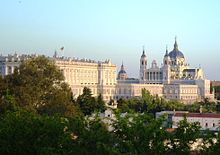 View of the Royal Palace and Almudena Cathedral from Debod Temple
View of the Royal Palace and Almudena Cathedral from Debod Temple
When Philip II moved his court permanently to Madrid, the city began to be embellished with various palaces, convents, churches and other historic buildings, most of which have survived to the present. This Madrid, known as the Madrid de los Austrias, is the most artistic and culturally rich of all historical times to the city. The chief architect of the time was Juan Gomez de Mora, stylistic heir of Juan de Herrera and their sober traces, but he began to use Baroque elements.The work of this stage is the Plaza Mayor, and many Baroque religious buildings.
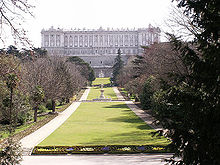 Royal Palace of Madrid (western façade) is the largest palace of Western Europe
Royal Palace of Madrid (western façade) is the largest palace of Western Europe
With the Bourbons began a new era in the city.The Royal Palace of Madrid and the buildings and monuments of the Paseo del Prado (Salón del Prado and Alcalá Gate) deserve special mention. They were constructed in a sober Baroque international style, often mistaken for neoclassical, by the Bourbon kings. Neoclassical also appears at this time, with Juan de Villanueva, who designed the building for El Prado Museum.
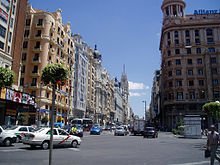 The Gran Via
The Gran Via
In the early 20th century began the construction of Gran Vía, with the task of freeing the old town. They used different styles that evolve over time: art nouveau, art deco, expressionist, etc. The Edificio Telefónica, of American inspiration, at the highest part of Gran Vía, is usually considered the first skyscraper in Europe. And finally (in Franco's period) the totalitarian style, the two skyscrapers in the Plaza de España.
Plans for the construction of a new cathedral for Madrid dedicated to the Virgin of Almudena began in the 16th century, but the slow construction did not begin until 1879. Francisco de Cubas, the Marquis of Cubas, was the architect who designed and directed the construction in a Gothic revival style. Construction ceased completely during the Spanish Civil War. The project was abandoned until 1950, when Fernando Chueca Goitia adapted the plans of de Cubas to a neoclassical style exterior to match the grey and white façade of the Palacio Real, which stands directly opposite. and was not completed until 1993, when the cathedral was consecrated by Pope John Paul II. On Calle Princesa, in the heart of the district of Moncloa, lies el Ejército del Aire, the headquarters of the Spanish Air Force. A scaled-down replica of the famous Monastery San Lorenzo del Escorial which lies about 50 kilometres northeast of Madrid, el Ejército del Aire is a classic example of Fascist Neoclassicism in Madrid.
The financial district in downtown Madrid between the streets Raimundo Fernández Villaverde, Orense, General Perón and Paseo de la Castellana, its original conception (and its name) to the "Plan General de Ordenación Urbana de Madrid", approved in 1946. The purpose of this plan was to create a huge block of modern office buildings with metro and railway connections in the expansion area of northern Madrid, just in front of Real Madrid stadium (currently named the Santiago Bernabéu Stadium) and beside the brand new government complex of Nuevos Ministerios. A botanical garden, a library and an opera house were also included in the plans, but these were never built.
Cuatro Torres Business Area is a business park that was completed in 2008. This block contains the tallest skyscrapers in Madrid and Spain (Torre Espacio, Torre de Cristal, Torre Sacyr Vallehermoso and Torre Caja Madrid). A new commercial and economic area with plenty of skylines is expected to be constructed during the next ten years according to the "Enlargement of Castellana Street Project".
Madrid Barajas International Airport Terminal 4, designed by Antonio Lamela and Richard Rogers (winning them the 2006 Stirling Prize), and TPS Engineers, (winning them the 2006 IStructE Award for Commercial Structures) was inaugurated on 5 February 2006. Terminal 4 is one of the world's largest terminal areas, with an area of 760,000 square metres (8,180,572 square feet) in two separate terminals: a main building, T4 (470,000 square metres), and satellite building, T4S (290,000 square metres), which are separated by approximately 2.5 km (2 mi). The new terminal is meant to give passengers a stress-free start to their journey. This is managed through careful use of illumination, available by glass panes instead of walls and numerous domes in the roof which allow natural light to pass through. With the new addition, Barajas is designed to handle 70 million passengers annually.
Environment
Madrid is the European city with the highest number of trees and green surface per inhabitant and it has the second highest number of aligned trees in the world, with 248,000 units, only exceeded by Tokyo. Madrid's citizens have access to a green area within a 15 minute walk. Since 1997, green areas have increased by 16%. At present, 8.2% of Madrid’s grounds are green areas, meaning that there are 16m2 of green area per inhabitant, far exceeding the 10m2 per inhabitant recommended by the World Health Organization.
Parque del Retiro, formerly the grounds of the palace built for Felipe IV, is Madrid's most popular park and the largest park in central Madrid. Its area is more than 1.4 km2 (350 acres) and it is located very close to the Puerta de Alcalá and not far from the Prado Museum. A magnificent park, filled with beautiful sculpture and monuments, galleries, a peaceful lake and host to a variety of events, it is one of Madrid's premier attractions. The park is entirely surrounded by the present-day city. Its lake in the middle once staged mini naval sham battles to amuse royalty; these days the more tranquil pastime of pleasure boating is popular. Inspired by London's crystal palace, the palacio de cristal can be found at the south-eastern end of the park.
In the Retiro Park is also the Forest of the Departed (Spanish Bosque de los Ausentes), a memorial monument to commemorate the 191 victims of the 11 March 2004 Madrid attacks.
Atocha Railway Station is not only the city's first and most central station but also home to a distinctive indoor garden with 4,000 square metres of tropical plants. Atocha station has become a hothouse destination in itself for plant lovers, with more than 500 species of plant life and ponds with turtle and goldfish in, as well as shops and cafes. It's a nice place to visit on a cold or wet day with its even temperature of 24 degrees Celsius, or even on a scorching summer day as a retreat from the heat.
 Casa de Campo, lake.
Casa de Campo, lake.
Casa de Campo is an enormous urban parkland to the west of the city, the largest in Spain and Madrid's main green lung. Its area is more than 1,700 hectares (6.6 sq mi). It is home to a fairground, the Madrid Zoo, an amusement park, the Parque de Atracciones de Madrid, and an outdoor municipal pool, to enjoy a bird's eye view of the park and city take a cable car trip above the tree tops. Casa de Campo's vegetation is one of its most important features. There are, in fact, three different ecosystems: oak, pine and river groves. The oak is the dominant tree species in the area and, although many of them are over 100 years old and reach a great height, they are also present in the form of chaparral and bushes. The pine-forest ecosystem boasts a large number of trees that have adapted perfectly to the light, dry conditions in the park. In addition, mushrooms often emerge after the first rains of autumn. Finally, the river groves, or riparian forests, are made up of various, mainly deciduous, species that grow in wetter areas. Examples include poplars, willows and alder trees. As regards fauna, this green space is home to approximately 133 vertebrate species.
The Royal Botanic Garden or Real Jardin Botanico is an 8-hectare botanical garden located in the Plaza de Murillo, next to the Prado Museum. It was an 18th century creation by Carlos III and it was used as a base for the plant species being collected across the globe. There is an important research facility that started life as a base to develop herbal remedies and to house the species collected from the new-world trips, today it is dedicated to maintaining Europe's ecosystem.
The Royal Palace is surrounded by three green areas. In front of the palace, are the gardens of the Plaza de Oriente; to the north, the gardens of Sabatini and to the west up to the Manzanares river, the famous Campo del Moro. Campo del Moro gardens has a surface area of 20 hectares and is a scenic garden with an unusual layout filled with foliage and an air of English romanticism. The Sabatini Gardens have a formal Neoclassic style, consisting of well-sheared hedges, in symmetric geometrical patterns, adorned with a pool, statues and fountains, with trees also disposed in a symmetrical geometric shape. Plaza de Oriente can distinguish three main plots: the Central Gardens, the Cabo Noval Gardens and the Lepanto Gardens. The Central Gardens are arranged around the central monument to Philip IV, in a grid, following the barroque model garden. They consist of seven flowerbeds, each packed with box hedges, forms of cypress, yew and magnolia of small size, and flower plantations, temporary. These are bounded on either side by rows of statues paths, popularly known as the Gothic kings, and mark the dividing line between the main body of the plaza and the Cabo Noval Gardens at north, and the Lepanto Gardens at south.
Monte de El Pardo is a mediterranean forest inside the city of Madrid. It is one of the best preserved Mediterranean Forests in Europe. The European Union has designated the Monte de El Pardo as a Special Protection Area for bird-life. This meadow, which has been used as hunting grounds by the royalty given the variety of game animals that have inhabited it since the Middle Ages, is home to 120 flora species and 200 vertebrae species. Rabbits, red partridges, wild cats, stags, deer and wild boars live among ilexes, cork oaks, ash trees, black poplars, oaks, junipers and rockroses. Monte del Pardo is part of the Regional Park of the High Basin of the Manzanares, spreading out from the Guadarrama Mountains range to the centre of Madrid, and protected by strong legal regulations. Just before crossing the city, the River Manzanares forms a valley composed by sandy elements and detritus from the mountain range.
Soto de Viñuelas, also known as Mount Viñuelas, is a meadow-oak forest north of the city of Madrid and east of the Monte de El Pardo. It is a fenced property of 3,000 hectares, which includes important ecological values, landscape and art. Soto de Viñuelas is part of the Regional Park of the High Basin of the Manzanares, a nature reserve which is recognised as a biosphere reserve by UNESCO, where it has been classified as Area B, the legal instrument that allows agricultural land use. Soto de Viñuelas also received the statement of Special Protection Area for Birds.
El Capricho is a 14-hectare garden located in the area of Barajas district. It dates back to 1784. The art of landscaping in El Capricho is displayed in three different styles of classical gardenscapes: the ‘parterre’ or French garden, English landscaping and the Italian giardino.
Madrid Rio is a linear park that runs along the bank of the Manzanares River, in the middle of Madrid. It is an area of parkland 10 kilometres long and covers 649 hectares in six districts: Moncloa-Aravaca, Centro, Arganzuela, Latina, Carabanchel and Usera. It is a large area of environmental, sporting, leisure and cultural interest. Madrid Río provides a link with other green spaces in the city such as Casa de Campo and the Linear Park of the Manzanares River. The main landscaped area in Madrid Río is the Arganzuela Park, covering 23 hectares where pedestrian and cycling routes cover the whole park. The Madrid Río cycle network covers some 30 kilometres and is linked to another bike routes. To the north, Madrid Rio connects to the Senda Real, the Green Ring for Cyclists and the E 7 (GR 10) trail, which goes as far as the Sierra de Madrid mountain range. To the south, Madrid Río provides access to the Enrique Tierno Galván Park and the Linear Park of the Manzanares River, an extensive green zone running parallel to the river as far as Getafe. As well as the cycle routes there are 42 kilometres of paths for walkers and runners. In the Salón de Pinos, a 6-kilometre long tree-lined promenade, there are circuits for aerobic and anaerobic exercise, while near the Puente de Praga bridge a tennis court and seven padel tennis courts.
The theme park Faunia,[32] is a natural history museum and zoo combined, aimed at being fun and educational for children. It comprises eight eco-systems from tropical rain forests to polar regions, and contains over 1,500 animals, some of which roam freely.
Economy
Main article: Economy of MadridMiddle Ages to 20th century
During the end of the Middle Ages, Madrid experienced astronomic growth as a consequence of its establishment as the new capital of the Spanish Empire. As Spain (like many other European countries) continued to centralize royal authority, this meant that Madrid took on greater importance as a center of administration for the Spanish Kingdom. It evolved to become an important nucleus of artisanal activity that eventually experienced industrial revolution during the 19th century. The city made even greater strides at expansion during the 20th century, especially after the Spanish Civil War, reaching levels of industrialization found in other European capital cities. The economy of the city was then centred on diverse manufacturing industries such as those related to motor vehicles, aircraft, chemicals, electronic devices, pharmaceuticals, processed food, printed materials, and leather goods.[33]
1992 to 2008
 AZCA (Business Park)
AZCA (Business Park)
Madrid is a major centre for international business and commerce. It is one of Europe's largest financial centres and the largest in Spain.
During the period from 1992 to 2006, Madrid experienced very significant growth in its service sector. The most notable of these services are those geared towards companies, followed by transport and communications, property and financial services. These four groups generate 51% of gross value added for Madrid’s economy and 62% of gross value added for the services sector. The importance of the Barajas Airport to the city's economy is substantial. The construction of housing and public works, such as the ringroads and train network, constituted a major pillar of the economy up to 2006.
As Spain has become decentralized politically, Madrid has taken on a smaller administrative profile as compared to the rest of the Spanish state. Even so, the Community of Madrid (centred upon the city of Madrid) experienced the highest growth of all the Spanish regions between 2004 to 2006. Its growth rate was higher than for the country as a whole by 1.4% during the period 2000–2006, and that of the Eurozone by 13%.[34]
Madrid has become the 23rd richest city in the world and third richest in Europe in terms of absolute GDP; the economic output for the year 2005 was of $201.5 billion, behind the considerably larger cities of Paris ($460 billion) and London ($452 billion) and ahead of Moscow and Barcelona.[35] Additionally in terms of GDP per capita, Madrid, in specific the Madrid region is the richest in Spain and one of the richest in Europe. At 133.9% of the European average of 25,800€ (34,572€/$48,313) Madrid is ahead of the all other 8 Spanish regions above 100%.[36] Similarly, Madrid is just 97.8% of New York's purchasing power.
Madrid is a world´s financial leader, rising to the top five Centres of Commerce in Europe. Madrid continues its upward trajectory as a key European city, rising from its 2007 spot at number 16 to number 11 globally and from number 6 to the number 5 spot in Europe. Madrid's stable GDP, exchange rate and strong bond market, coupled with a high standard of living, place this city in the company of Europe's most prominent cities: London, Paris, Frankfurt and Amsterdam.[37]
Madrid is one of the cities in the Iberian Peninsula that attracts most foreign investment and job seekers. The average salary in Madrid during 2007 was 2540€, clearly above the Spanish average of 2085€.[38] In terms of net earnings, Madrid also places first in Spain; Madrid is 28th in the world, at 78.6%.[39]
Demographics
Year Municipality Community % 1897 542,739 730,807 74.27 1900 575,675 773,011 74.47 1910 614,322 831,254 73.90 1920 823,711 1,048,908 78.53 1930 1,041,767 1,290,445 80.73 1940 1,322,835 1,574,134 84.04 1950 1,553,338 1,823,418 85.19 1960 2,177,123 2,510,217 86.73 1970 3,120,941 3,761,348 82.97 1981 3,158,818 4,686,895 67.40 1991 3,010,492 4,647,555 64.78 2001 2,938,723 5,423,384 54.19 2005 3,155,359 5,964,143 52.90 2006 3,128,600 6,008,183 52.07 2007 3,132,463 6,081,689 51.51 2008 3,213,271 6,271,638 51.23 2009 3,255,944 6,386,932 50.98 2010 3.273.049 6.458.684 50.68 Source: INE The population of Madrid generally increased from when the city became the national capital in the mid-16th century and stabilised at about 3 million from the 1970s.
From around 1970 until the mid 1990s, the city's population dropped. This phenomenon, which also affected other European cities, was caused in part by the growth of satellite suburbs at the expense of the downtown. Another reason might have been the slowdown in the rate of growth of the European economy.
The demographic boom accelerated in the late 1990s and early first decade of the 21st century due to international immigration, in response to a surge in Spanish economic growth. According to census data, the population of the city grew by 271,856 between 2001 and 2005.
As the capital city of Spain, the city has attracted many immigrants from around the world. About 83.8% of the inhabitants are Spaniards, while people of other origins, including immigrants from Latin America, Europe, Asia, North Africa and West Africa, represented 16.2% of the population in 2007.[40]
The ten largest immigrant groups include: Ecuadorian: 104,184, Romanian: 52,875, Bolivian: 44,044, Colombian: 35,971, Peruvian: 35,083, Chinese: 34,666, Moroccan: 32,498, Dominican: 19,602, Brazilian: 14,583, and Paraguayan: 14,308. There are also important communities of Filipinos, Equatorial Guineans, Bulgarians, Indians, Italians, Argentines, Senegalese and Poles.[40]
Districts that host the largest number of immigrants are Usera (28.37%), Centro (26.87%), Carabanchel (22.72%) and Tetuán (21.54%). Districts that host the smallest number are Fuencarral-El Pardo (9.27%), Retiro (9.64%) and Chamartin (11.74%).
Government
See also: List of mayors of MadridThe City Council consists of 57 members, one of them being the Mayor, currently Alberto Ruiz-Gallardón Jiménez. The Mayor presides over the Council.
The Plenary of the Council, is the body of political representation of the citizens in the municipal government. Some of its attributions are: fiscal matters, the election and deposition of the Mayor, the approval and modification of decrees and regulations, the approval of budgets, the agreements related to the limits and alteration of the municipal term, the services management, the participation in supramunicipal organizations, etc.[41] Nowadays, mayoral team consists of the Mayor, the Deputy Mayor and 8 Delegates; all of them form The Board of Delegates (the Municipal Executive Committee).[42]
Madrid has tended to be a stronghold of the People's Party, which has controlled the city's mayoralty since 1989. In the 2007 regional and local elections, the conservative People's Party (PP, centre-right political party) obtained 34 seats, the Spanish Socialist Workers' Party (PSOE, centre-left political party) obtained 18 and United Left (IU, left political party) obtained 5.
Alberto Ruiz-Gallardón Jiménez has been in office since 2003, when he left the Presidency of the Autonomous Community of Madrid and stood as the candidate to replace outgoing mayor José María Álvarez del Manzano, also from the PP. In the last local elections of 2007, Ruiz-Gallardón increased the PP majority in the City Council to 34 seats out of 57, taking 55.5% of the popular vote and winning in all but two districts.
Culture
Madrid is one of Spain's most popular destinations and is renowned for its large quantity of cultural attractions.
Art galleries and museums
Madrid is considered one of the top European destinations concerning art museums. Best known is the Golden Triangle of Art, located along the Paseo del Prado and comprising three museums. The most famous one is the Prado Museum, known for such highlights as Diego Velázquez's Las Meninas and Francisco de Goya's La maja vestida and La maja desnuda. The other two museums are the Thyssen Bornemisza Museum, established from a mixed private collection, and the Reina Sofia Museum, where Pablo Picasso's Guernica hangs, returning to Spain from New York after more than two decades.
The Museo del Prado is a museum and art gallery that features one of the world's finest collections of European art, from the 12th century to the early 19th century, based on the former Spanish Royal Collection. The collection currently comprises around 7,600 paintings, 1,000 sculptures, 4,800 prints and 8,200 drawings, in addition to a large number of works of art and historic documents. El Prado is one of the most visited museums in the world, and it is considered to be among the greatest museums of art. It has the best collection of artworks by Goya, Velázquez, El Greco, Rubens, Titian, Hieronymus Bosch, José de Ribera and Patinir; and works by Rogier van der Weyden, Raphael, Tintoretto, Veronese, Caravaggio, Van Dyck, Albrecht Dürer, Claude Lorrain, Murillo and Zurbarán, among others.[43]
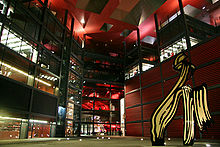 Museo Reina Sofía (MNCARS).
Museo Reina Sofía (MNCARS).
The Museo Nacional Centro de Arte Reina Sofía (MNCARS) is the Spain's national museum of 20th century art. The museum is mainly dedicated to Spanish art. Highlights of the museum include excellent collections of Spain's greatest 20th century masters, Pablo Picasso, Salvador Dalí, Joan Miró, Juan Gris and Julio González. Certainly the most famous masterpiece in the museum is Picasso's painting Guernica. The Reina Sofía also hosts a free-access library specializing in art, with a collection of over 100,000 books, over 3,500 sound recordings and almost 1,000 videos.[44]
The Thyssen-Bornemisza Museum is an art museum that fills the historical gaps in its counterparts' collections: in the Prado's case this includes Italian primitives and works from the English, Dutch and German schools, while in the case of the Reina Sofia the Thyssen-Bornemisza collection, once the second largest private collection in the world after the British Royal Collection,[45] includes Impressionists, Expressionists, and European and American paintings from the second half of the 20th century, with over 1,600 paintings.[46]
The Royal Academy of Fine Arts of San Fernando currently functions as a museum and gallery that houses a fine art collection of paintings from the 15th to 20th century: Giovanni Bellini, Correggio, Rubens, Zurbarán, Murillo, Goya, Juan Gris, Pablo Serrano. The academy is also the headquarters of the Madrid Academy of Art. Francisco Goya was once one of the academy's directors, and, its alumni include Pablo Picasso, Salvador Dalí, Antonio López García, Juan Luna, and Fernando Botero.[47][48]
The Royal Palace of Madrid is the official residence of Juan Carlos I of Spain, but he uses it only for official acts. It is a baroque palace full of artworks is one of the largest European Royal Palaces, which is characterized by its luxurious rooms and its rich collections of armors and weapons, pharmaceutical, silverware, watches, paintings, tapestries and the most comprehensive collection of Stradivarius in the world[49]
The National Archaeological Museum of Spain collection includes, among others, Pre-historic, Celtic, Iberian, Greek and Roman antiquities and medieval (Visigothic, Muslim and Christian) objects. Highlights include a replica of the Altamira cave (the first cave in which prehistoric cave paintings were discovered), Lady of Elx (an enigmatic polychrome stone bust), Lady of Baza (a famous example of Iberian sculpture), Biche of Balazote (an iberian sculpture) and Treasure of Guarrazar (a treasure that represents the best surviving group of Early Medieval Christian votive offerings and the high point of Visigothic goldsmith's work).[50]
The Museum of the Americas (Spanish: Museo de América) is a National museum that holds artistic, archaeological and ethnographic collections from the whole American continent, ranging from the Paleolithic period to the present day. The permanent exhibit is divided into five major thematical areas: an awareness of America, the reality of America, society, religion and communication.[51]
The National Museum of Natural Sciences is the National Museum of Natural History of Spain. The research departments of the museum are: Biodiversity and Evolutionary Biology, Evolutionary Ecology, Paleobiology, Vulcanology and Geology.[52]
The Naval Museum is managed by the Ministry of Defence. The Museum's mission is to acquire, preserve, investigate, report and display for study, education and contemplation, parts, sets and collections of historical, artistic, scientific and technical related to naval activity in order to disseminate the story sea of Spain; to help illustrate, highlight and preserve their traditions and promote national maritime awareness.
The Monastery of Las Descalzas Reales resides in the former palace of King Charles I of Spain and Isabel of Portugal. Their daughter, Joan of Austria, founded this convent of nuns of the Poor Clare order in 1559. Throughout the remainder of the 16th century and into the 17th century, the convent attracted young widowed or spinster noblewomen. Each woman brought with her a dowry. The riches quickly piled up, and the convent became one of the richest convents in all of Europe. It has many works of Renaissance and Baroque art, including a recumbent Christ by Gaspar Becerra, a staircase whose paintings were painted by unknown author (perhaps Velázquez) and they are considered the masterpiece of Spanish illusionist paint, and Brussels tapestries inspired in paintings by Rubens.[53]
The Museo Lázaro Galdiano houses an encyclopedic collection specializing in decorative arts. The collection includes paintings by Leonardo da Vinci, Claudio Coello, Goya, Pedro Berruguete, El Greco, Hieronymus Bosch, Rembrandt, Thomas Gainsborough, Thomas Lawrence and Joshua Reynolds, sculptures by Giambologna and Verrocchio; 10th century Byzantine enamel; Arab and Byzantine ivory chests; Hellenistic, Roman, medieval, renaissance, baroque and romantic jewerly; Pisanello and Pompeo Leoni medals; Spanish and Italian ceramics; Italian and Arab clothes; and an interesting collection of weapons including the sword of Pope Innocent VIII.[54]
The Museo Nacional de Artes Decorativas (National Museum of Decorative Arts) is one of the oldest museums in the city. It illustrates the evolution of the called "minor arts" (furniture, ceramics and glass, textile, etc.). Its 60 rooms expones 15,000 objects, of the approximate 40,000 which it has.[55]
The Museo Nacional del Romanticismo (National Museum of Romanticism) contains a large collection of artefacts and art, focusing on daily life and customs of the 19th century, with special attention to the aesthetics about Romanticism.[56]
The Museo Cerralbo houses a private collection of ancient works of art, artifacts and other antiquities collected by Enrique de Aguilera y Gamboa, XVII Cerralbo Marquis.[57]
The Museo Nacional de Antropología(National Museum of Antropology) provides an overview of the different cultures in the world, with objects and human remains from around the world, highlighting a Guanche mummy of the island of Tenerife.[58]
The Museo Sorolla is located in the building in which the Valencian Impressionist painter had his home and workshop. The collection includes, in addition to numerous works of Joaquín Sorolla, a large number of objects that possessed the artist, including sculptures by August Rodin.[59]
CaixaForum Madrid is a post-modern art gallery in the centre of Madrid. It is sponsored by the Catalan-Balearic bank la Caixa and located next to the Salón del Prado. Although the CaixaForum is a modern building, it also exhibits retrospectives of artists from earlier time periods and has evolved into one of the most visited museums in Madrid. It was constructed by the Swiss architects Herzog & de Meuron from 2001 to 2007, which combined an old unused industrial building and hollowed it out at the base and inside and placed on top further floors which are encased with rusted steel. Next to it is an art installation of green plants growing on the wall of the neighbouring house by French botanist Patrick Blanc. The red of the top floors with the green of the wall next to it form a contrast. The green is in reflection of the neighbouring Royal Botanical Gardens.
Another art galleries and museums in Madrid are, among others:
- Casa-Museo José Padilla
- Casa-Museo Manuel Benedito
- Museo de Antropologia Médica
- Museo De La Farmacia Hispana
- Museo Del Reloj Grassy, at Edificio Grassy
- Museo Casa de la Moneda
- Museo de Historia de Madrid
- Museo de los Orígenes
- Royal Palace of El Pardo
Churches
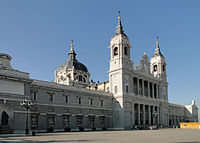 Almudena Cathedral, Catedral de la Almudena
Almudena Cathedral, Catedral de la Almudena
 St. Jerome Church, San Jeronimo el Real
St. Jerome Church, San Jeronimo el Real
Madrid has a considerable number of Catholic churches, some of them are between the most important Spanish religious artworks.
The oldest church that survives today is San Nicolás de los Servitas, whose oldest item is the bell tower (12th century), in Mudejar style. The next oldest temple is San Pedro el Real, with its high brick tower.
St. Jerome Church is a gothic church next to El Prado Museum. The Catholic Monarchs ordered its construction in the 15th century, as part of a vanished monastery. The monastery's cloister is preserved. It has recently been renovated by Rafael Moneo, with the goal to house the neoclassical collection of El Prado Museum, and also sculptures by Leone Leoni and Pompeo Leoni.
The Bishop Chapel is a gothic chapel which was built in the 16th century by order of the Bishop of Plasencia, Gutierre de Vargas. It was originally built to house the remains of Saint Isidore Laborer (Madrid's patron saint), but it was used as the Vargas family mausoleum. Inside are the altairpiece and the tombs of the Vargas family, which were the work of Francisco Giralte, a disciple of Alonso Berruguete. They are considered masterpieces of Spanish Renaissance sculpture.
St. Isidore Cathedral was built between 1620–1664 by order of Empress Maria of Austria, daughter of Charles V of Germany and I of Spain, to become part of a school run by the Jesuits which still exists today. Its dome is the first example of a dome drawing on a wooden frame covered with plaster, which, given its lightness makes it easy to support the walls. It was the cathedral of Madrid between 1885 and 1993, which is the time it took to build the Almudena. The artwork inside were mostly burned during the Spanish Civil War, but it retained the tomb that holds the incorrupt body of Saint Isidore Laborer and the urn containing the ashes of his wife Maria Torribia.
Royal Convent of La Encarnación is an Augustinian Recollect convent. The institution, which belonged ladies of the nobility, was founded by Queen Margaret of Austria, wife of Philip III of Spain, in the early 17th century. Due to the frescoes and sculptures which houses is one of the most prominent temples in the city. The building's architect was Fray Alberto de la Madre de Dios, who built it between 1611 and 1616. The façade responds to an inspiring Herrerian style, with great austerity,and it was imitated by other Spanish churches. The church's interior is a sumptuous work by the great Baroque architect Ventura Rodriguez. In the church are preserved shrines containing the blood of St. Januarius and St. Pantaleon, the second (according to tradition) liquefies every year on the saint's day on 27 July.
San Antonio de los Alemanes (St. Anthony Church) is a pretty 17th century church which was originally part of a Portuguese hospital. Subsequently it was donated to the Germans living in the city.
The interior of the church has been recently restored. It has some beautiful frescoes painted by Luca Giordano, Francisco Carreño and Francisco Rizi. The frescoes represent some kings of Spain, Hungary, France, Germany and Bohemia. They all sit looking at the paintings in the vault, which represent the life of Saint Anthony of Padua.
Royal Chapel of St. Anthony of La Florida is sometimes named the "Goya's Sixtine Chapel". The chapel was built on orders of King Charles IV of Spain, who also commissioned the frescoes by Goya. These were completed over a six month period in 1798. The frescoes portray miracles by Saint Anthony of Padua, including one which occurred in Lisbon, but which the painter has relocated to Madrid. On every June 13, the chapel becomes the site of a lively pilgrimage in which young unwed women come to pray to St. Anthony and to ask for a partner.
San Francisco el Grande Basilica was built in neoclassical style in the second half of the 18th century by Francesco Sabatini. It has the fifth largest diameter dome to Christianity. (33 meters in diameter: it's smaller than the dome of the Rome's Pantheon (43.4meters), St. Peter's Basilica (42.4 meters), the Florence Cathedral (42 meters)and the Rotunda of Mosta (37.2 meters) in Malta, but it's larger than St. Paul's Cathedral (30.8 meters) in London and Hagia Sophia (31.8 meters) in Istanbul). The church is dedicated to St. Francis of Assisi, who according to legend was established in Madrid during his pilgrimage to Santiago de Compostela. Its sumptuous interior features many artworks, including paintings by Goya and Zurbarán.
The Cathedral of Santa Maria la Real de la Almudena is the episcopal seat of the Archdiocese of Madrid. It is a temple of 102 meters long and 73 high, built during the 19th and 20th century in a mixture of different styles: neoclassical exterior, neo-Gothic interior and neo-Romanesque crypt and neo-Byzantine abse's paints. The cathedral was built in the same place which was built the Moorish citadel (al-mudayna) in Madrid. It was consecrated by Pope John Paul II on his fourth trip to Spain on June 15, 1993, thus being the only Spanish cathedral dedicated by a pope.
Literature
 Cervantes Institute headquarters.
Cervantes Institute headquarters.
Madrid has been one of the great centers of Spanish literature. In this city were born some of the best writers of the Spanish Golden Century, including: Lope de Vega (Fuente Ovejuna, The Dog in the Manger, The Knight of Olmedo), who reformed the Spanish theater, a work continued by Calderon de la Barca (Life is a Dream), Francisco de Quevedo, Spanish nobleman and writer famous for his satires, which criticized the Spanish society of his time, and author of ´El Buscón. And finally, Tirso de Molina, who created the famous character Don Juan. In addition, Cervantes and Góngora also lived in the city, although they not born there. The homes of Lope de Vega, Quevedo, Gongora and Cervantes are still preserved, and they are all in the Barrio de las Letras (Letters Neigtbourhood).
Other writers born in Madrid in later centuries have been Leandro Fernandez de Moratín, Mariano José de Larra, Jose de Echegaray (Nobel Prize in Literature), Ramón Gómez de la Serna, Dámaso Alonso, Enrique Jardiel Poncela and Pedro Salinas.
Madrid is home to the Royal Academy of Spanish Language, internationally important cultural institution dedicated to language planning by enacting legislation aimed at promoting linguistic unity within and among the several Hispanic states; ensure a common linguistic standard, in accordance with its founding statutes "to ensure that the changes undergone [by the language] [...] not break the essential unity that keeps all the Hispanic. ".[60]
Madrid is also home to another internationally cultural institution, the Instituto Cervantes, whose task is the promotion and teaching of Spanish language as well as the dissemination of the culture of Spain and Latin America.
The National Library of Spain is a major public library, the largest in Spain. The library's collection consists of more than 26,000,000 items including 15,000,000 books and other printed materials, 30,000 manuscripts, 143,000 newspapers and serials, 4,500,000 graphic materials, 510,000 music scores, 500,000 maps, 600,000 sound recording, 90,000 audiovisuals, 90,000 electronic documents, more than 500,000 microforms, etc.".[61]
Nightlife
The nightlife in Madrid is undoubtedly one of the city's main attractions. Tapas bars, cocktail bars, clubs, jazz lounges, live music venues, flamenco theatres and establishments of all kinds cater for all tastes and ages. Every night, venues pertaining to the Live Music Venues Association La Noche en Vivo host a wide range of live music shows. Everything from acclaimed to up-and-coming artists, singer-songwriters to rock bands, jazz concerts or electronic music sessions to enjoy music at its best.
Nightlife and young cultural awakening flourished after the death of Franco, especially during the 80s while Madrid's mayor Enrique Tierno Galván (PSOE) was in office, at this time is well-known the cultural movement called la movida and it initially gathered around Plaza del Dos de Mayo. Nowadays, the Malasaña area is known for its alternative scene.
Some of the most popular night destinations include the neighbourhoods of: Bilbao, Tribunal, Atocha, Alonso Martinez or Moncloa, together with Puerta del Sol area (including Opera and Gran Via, both adjacent to the popular square) and Huertas (barrio de Las Letras), destinations which are also filled with tourists day and night. The district of Chueca has also become a hot spot in the Madrilenian night life, especially for the gay population. Chueca is popularly known as the gay quarter, comparable to The Castro district in San Francisco.
What is also popular is the practice of meeting in parks or streets with friends and drinking alcohol together (this is called 'botellón', from 'botella', bottle), but in recent years, drinking in the street is punished with a fine and now young madrileños drink together all around the city instead of in better-known places.
Bohemian Culture
The city has venues for performing alternative art and expressive art. They are mostly located in the centre of the city include in Opera, Anton Martin, Chueca and Malasaña. There are also several festivals in Madrid including the Festival of Alternative art the Festival of the Alternative Scene.[62][63][64][65]
The neighbourhood of Malasaña as well as Anton Martin and Lavapies hosts several bohemian cafe/galleries. These cafes are typified with period or retro furniture or furniture found on the street, a colourful non traditional atmosphere inside, and usually art displayed each month by a new artist, often for sale. Cafes include the retro cafe "Lolina" and bohemian cafes "La Ida", "La Paca" and "Cafe de la Luz" in Malasaña, "La Piola" in Huertas and "Cafe Olmo" and "Aguardiente" in Lavapies.[66]
In the neighbourhood of Lavapies, there are also "hidden houses", which are illegal bars or abandoned spaces where concerts, poetry reading and[67][68][69] the famous Spanish Botellon (a street party or gathering now illegal but rarely stopped).
Classical music and opera
The Auditorio Nacional de Música [70] is the main venue for classical music concerts in Madrid. It is home to the Spanish National Orchestra, the Chamartín Symphony Orchestra[71] and the venue for the symphonic concerts of the Community of Madrid Orchestra and the Madrid Symphony Orchestra. It is also the principal venue for orchestras on tour playing in Madrid.
The Teatro Real is the main opera house in Madrid, located just in front of the Royal Palace, and its resident orchestra is the Madrid Symphony Orchestra.[72] The theatre stages around seventeen opera titles (both own productions and co-productions with other major European opera houses) per year, as well as two or three major ballets and several recitals.
The Teatro de la Zarzuela is mainly devoted to Zarzuela (the Spanish traditional musical theatre genre), as well as operetta and recitals.[73][74] The resident orchestra of the theatre is the Community of Madrid Orchestra.
The Teatro Monumental is the concert venue of the RTVE Symphony Orchestra.[75]
Other concert venues for classical music are the Fundación Joan March and the Auditorio 400, devoted to contemporary music.
Bullfighting
Madrid hosts the largest Plaza de Toros (bullring) in Spain, Las Ventas, established in 1929. Las Ventas is considered by many to be the world centre of bullfighting and has a seating capacity of almost 25,000. Madrid's bullfighting season begins in March and ends in October. Bullfights are held every day during the festivities of San Isidro (Madrid's patron saint) from mid May to early June, and every Sunday, and public holiday, the rest of the season. The style of the plaza is Neomudéjar. Las Ventas also hosts music concerts and other events outside of the bullfighting season.
Local festivities
- 15 May, San Isidro Labrador (Madrid's patron saint).
- 13 June, San Antonio de la Florida (Moncloa neighbourhood's patron saint)..
- 16–25 July, Virgen del Carmen festivities (Vallecas neighbourhood's patron saint).
- 6–14 August, Virgen de la Paloma festivities (Madrid's popular patron saint)
- 7 August, San Cayetano (Cascorro neighbourhood's patron saint).
- 10 August, San Lorenzo (Lavapiés neighbourhood's patron saint).
- 9 November, Virgen de la Almudena festivities (Madrid's patron saint).
Sport
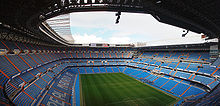 The Santiago Bernabéu, a FIFA elite stadium.
The Santiago Bernabéu, a FIFA elite stadium.
Madrid is home to La Liga football club Real Madrid, who play their home games at the Santiago Bernabéu. Their supporters are referred to as Madridistas or Merengues (Merengues). Real Madrid is one of the most prestigious football clubs in the world (FIFA selected Real Madrid the best team of the 20th century), having won a record 9 European Cups. Their hometown rivals, Atlético Madrid, are also well supported in the city. The players (and supporters) are referred to as Colchoneros (The Mattress Makers), in reference to the team's red & white jersey colours, which were determined by mattress material being the cheapest at the time of the club's formation. In 1982, Madrid hosted the FIFA World Cup Final. Along with Barcelona, Glasgow and Lisbon, Madrid is one of only four cities in Europe to contain two UEFA 5-star stadia: Real Madrid's Santiago Bernabéu and Atlético Madrid's Vicente Calderón both meet the said criteria. Rayo Vallecano and Getafe CF are two further teams from the Madrid area playing currently in La Liga.
Some of Spain's top footballers are Madrileños (born in Madrid), including Real Madrid former player Emilio Butragueño and co (La Quinta del Buitre, "The Vulture's Quint"), Premier League's Pepe Reina, Fernando Torres and Real Madrid veterans Raúl González, Guti Hernandez and Iker Casillas.
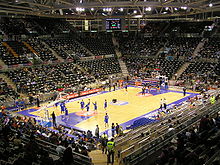 Madrid Arena interior
Madrid Arena interior
Madrid boasts a prominent place in Spanish basketball, with two clubs in the country's top-level Liga ACB. Real Madrid's basketball section has won 30 Spanish League championships, 22 Spanish Cup championships, 8 Euroleague Championships, 4 Saporta Cups, 4 Intercontinental Cups and have won 2 Triple Crowns. Madrid's other professional basketball club is Estudiantes that have won 3 Spanish Cup championships.
Madrid hosts the Mutua Madrileña Madrid Open. The tournament is classified as an ATP World Tour Masters 1000 event on the Association of Tennis Professionals tour, and a Premier Mandatory event on the Women's Tennis Association tour. Caja Mágica (The Magic Box, and also known as the Manzanares Park Tennis Centre) is a tennis structure located at Manzanares Park, used for the Madrid Masters tournament.
The city is also host to the Circuito Permanente Del Jarama, a motorsport race circuit.
Historically, the city serves as the final stage of the Vuelta a España cycling event, in the same way Paris serves as the conclusive stage of the Tour de France.
Skiing is possible in the nearby mountains of the Sierra de Guadarrama, where the ski resorts of Valdesqui and Navacerrada are located.
In the past, Madrid has bid to host the 1972 Summer Olympics, the 2012 Summer Olympics, and the 2016 Summer Olympics, which were awarded to Munich, London, and Rio de Janeiro respectively. The city has two major annual road running events – the Madrid Marathon and the San Silvestre Vallecana 10 km (6 mi) run – tens of thousands of runners take part in these races each year.[76] As reported by Olympic news outlet Around the Rings,[77] In July 2011 Madrid Mayor Alberto Ruiz-Gallardon announced Madrid's plans to bid for the 2020 Olympics.[78]
Club League Sport Venue Established Capacity Real Madrid C.F. La Liga Football Santiago Bernabéu 1902 80,354 Atlético Madrid La Liga Football Vicente Calderón 1903 54,851 Rayo Vallecano La Liga Football Estadio de Vallecas 1924 15,500 Real Madrid Castilla Segunda División B Football Alfredo di Stéfano 1930 6,000 Real Madrid Baloncesto ACB Basketball Palacio de Deportes de Madrid 1932 16,000 CB Estudiantes ACB Basketball Palacio de Deportes de Madrid 1948 16,000 Education
Main article: Education in SpainState Education in Spain is free, and compulsory from 6 to 16 years. The current education system is called LOE (Ley Orgánica de Educación).[79]
Universities
Madrid is home to a large number of public and private universities. Some of them are among the oldest in the world, and many of them are the most prestigious universities in Spain.
 Complutense University of Madrid, founded 1293
Complutense University of Madrid, founded 1293
The Complutense University of Madrid is the largest university in Spain and one of the oldest universities in the world. It has 10,000 staff members and a student population of 117,000. Nearly all academic staff are Spanish. It is located on two campuses, in the university quarter Ciudad Universitaria at Moncloa in Madrid, and in Somosaguas.[80] The Complutense University of Madrid was founded in Alcala de Henares, old Complutum, by Cardinal Cisneros in 1499. Nevertherless, its real origin dates back from 1293, when King Sancho IV of Castile built the General Schools of Alcalá, which would give rise to Cisnero's Complutense University. During the course of 1509–1510 five schools were already operative: Artes y Filosofía (Arts & Philosophy), Teología (Theology), Derecho Canónico (Canonical Laws), Letras (Liberal Arts) and Medicina (Medicine). In 1836, during the reign of Isabel II, the University was moved to Madrid, where it took the name of Central University and was located at San Bernardo Street. Subsequently, in 1927, a new university area was planned to be built in the district of Moncloa-Aravaca, in lands handed over by the King Alfonso XIII to this purpose. The Spanish Civil War turned the "Ciudad Universitaria" into a war zone, causing the destruction of several schools in the area, as well as the loss of part of its rich scientific, artistic and bibliographic heritage. In 1970 the Government reformed the High Education, and the Central University became the Complutense University of Madrid. It was then when the new campus at Somosaguas was created to house the new School of Social Sciences. The old Alcalá campus was reopened as the independent UAH, University of Alcalá, in 1977. Complutense also serves to the population of students who select Madrid as their residency during their study abroad period. Students from the United States for example, might go to Madrid on a program like API (Academic Programs International) and study at Complutense for an intense immersion into the Spanish Language. The beautiful setting of the campus allows students living temporarily in Madrid to have access to all of the city's public features including Retiro Park, El Prado Museum, and much more. After studying at the University, students return home with a fluent sense of Spanish as well as culture and diversity.[81]
School of Mines, Technical University of Madrid.
The Universidad Politécnica de Madrid (Technical University of Madrid), is the top technical university in Spain. It is the result of the merge of different Technical Schools of Engineering.
The Autonomous University of Madrid was instituted under the leadership of the famous physicist, Nicolás Cabrera. The Autonoma is widely recognised for its research strengths in theoretical physics. Known simply as la Autónoma in Madrid, its main site is the Cantoblanco Campus, situated 10 miles (16 km) to the northeast of the capital (M-607) and close to the municipal areas of Madrid, namely Alcobendas, San Sebastián de los Reyes, Tres Cantos and Colmenar Viejo. Located on the main site are the Rectorate building and the Faculties of Science, Philosophy and Fine Arts, Law, Economic Science and Business Studies, Psychology, Higher School of Computing Science and Engineering, and the Faculty of Teacher Training and Education. The Medical School is sited outside the main site and beside the Hospital Universitario La Paz.[82]
The Universidad Carlos III de Madrid, whose philosophy is to create responsible free-thinking people with a sensitivity to social problems and an involvement in the concept of progress based on freedom, justice and tolerance. The undergraduate degrees in Business Administration, Economics and Law are ranked first, first and second respectively among those offered by public and private universities in Spain,[83] and its Master and PhD programs also rank top in the country.[84] The Department of Economics[85] is among the 50 best worldwide, and in the top 10 in Econometrics.[86]
Some other prestigious universities include Universidad de Alcalá de Henares, rebuilt at Alcalá de Henares in 1975; and the Universidad Pontificia Comillas, involved in a number of academic exchange programmes, work practice schemes and international projects with over 200 Higher Education Institutions in Europe, Latin America, North America and Asia.
Other universities in Madrid, some of them private, are: Rey Juan Carlos University (public), Universidad Alfonso X, Universidad Antonio de Nebrija, Universidad Camilo José Cela, Universidad Francisco de Vitoria, Universidad Europea de Madrid, Universidad Pontificia de Salamanca Campus de Madrid, Saint Louis University Madrid Campus and Universidad San Pablo CEU (all of them private).
Madrid is also home to the Escuela Superior de Música Reina Sofía, the Real Conservatorio Superior de Música de Madrid and many other private educational institutions.
Business schools
IE Business School (formerly Instituto de Empresa) has its main campus on the border of the Chamartín and Salamanca districts of Madrid. IE Business School recently ranked #1 in WSJ's 2009 rankings for Best MBA Programs under 2 years. It scored ahead of usual stalwarts, INSEAD and IMD, giving it top billing amongst International MBA programs. Although based in Barcelona, both IESE Business School and ESADE Business School also have Madrid campuses. These three schools are the top-ranked business schools in Spain, consistently rank among the top 20 business schools globally, and offer MBA programs (in English or Spanish) as well as other business degrees. Other Madrid universities that have MBA programs include:
- Universidad Carlos III de Madrid through the Centro de Ampliación Estudios (in English or Spanish).
- Universidad Pontificia Comillas de Madrid (in Spanish only).
- Universidad Politécnica de Madrid (in Spanish only).
Transport
Madrid is served by highly-developed communication infrastructures, making the Spanish capital the leading logistics hub for both Spain and all of southern Europe. It also boasts a network of motorways, encompassing both ring roads and radial roads, and provides the backbone for Spain’s railway network, thereby providing effective connections with not only other parts of the region, but also the rest of Spain and Europe as a whole. Madrid ranks alongside Tokyo and Paris as one of the world’s three largest high-speed railway hubs. Madrid is also home to the Madrid-Barajas airport, Spain’s flagship airport and one of the largest to be found worldwide.
Air
Main article: Madrid-Barajas AirportMadrid is served by Barajas Airport. Barajas is the main hub of Iberia Airlines. It consequently serves as the main gateway to the Iberian peninsula from Europe, America and the rest of the world. Current passenger volumes range upwards of 49.8 million passengers per year, making it the country's largest and busiest airport, and in 2009 it was the world's 11th busiest airport[87] and Europe's fourth busiest airport. Given annual increases close to 10%, a new fourth terminal has been constructed. It has significantly reduced delays and doubled the capacity of the airport to more than 70 million passengers per year. Two additional runways have also been constructed, making Barajas a fully operational four-runway airport.
Located within the city limits of Madrid, just 9 km (5.6 mi) from the city's financial district and 13 km (8.1 mi) northeast of the Puerta del Sol, Madrid's historic centre. The airport name derives from the adjacent district of Barajas, which has its own metro station on the same rail line serving the airport.
The Councillor of Transports of the Community of Madrid, Manuel Lamela, announced in 2007 that the city will also be served by two new airports which are expected to be fully operative in 2016, the first of which will be located in Campo Real, it will be initially be used for cargo flights, but also as hub for low-cost carriers, and the second one, expected to be built between the two municipalities of El Álamo and Navalcarnero, which will only take over the routes operating in Cuatro Vientos Airport.
National rail
Main article: Cercanías MadridSpain's railway system, the Red Nacional de Ferrocarriles Españoles (Renfe) operates the vast majority of Spain's railways. Cercanías Madrid is the commuter rail service that serves Madrid and its metropolitan area. It is operated by Cercanías Renfe, the commuter rail division of Renfe. The total length spans 339.1 km. Main rail terminals are Atocha in the south and Chamartín in the north.
The most important project in the next decade is the Spanish high speed rail network, Alta Velocidad Española AVE. Currently, an ambitious plan includes the construction of a 7,000-kilometre (4,300 mi) network, centred on Madrid. The overall goal is to have all important provincial cities be no more than 4 hours away from Madrid, and no more than 6 hours away from Barcelona. As of 2008, AVE high-speed trains link Atocha station to Seville, Málaga, Córdoba, Ciudad Real and Toledo in the south and to Cuenca, Albacete, Valencia, Zaragoza, Lleida, Tarragona and Barcelona in the east. AVE trains also arrive from Valladolid in the north.
RENFE offers:
Metro
Main article: Madrid MetroServing a population of some four million, the Madrid Metro is one of the most extensive and fastest-growing metro networks in the world.[88] With the addition of a loop serving suburbs to Madrid's south-west "Metrosur", it is now the second largest metro system in Western Europe, second only to London's Underground. In 2007 Madrid's metro system was expanded and it currently runs over 283 kilometres (176 mi) of line. The province of Madrid is also served by an extensive commuter rail network of 370 kilometres (230 mi) called Cercanías.
The system is the sixth longest metro in the world after London, New York, Moscow, Seoul and Shanghai, though Madrid is approximately the fiftieth most populous metropolitan area in the world. Its fast growth in the last 20 years has also put it among the fastest growing networks in the world, on par with the Shanghai Metro and the Beijing Subway. Unlike normal Spanish road and rail traffic, Madrid Metro trains use left-hand running on some lines due to historical reasons.
Buses
This railway network is ably supported by an ever-expanding network of city buses. The overall length of the bus network of Madrid’s Municipal Transport Corporation (Empresa Municipal de Transportes, or EMT) at yearclose 2008, when 426 million passengers were transported, stood at 3,690 kilometres, marking a 31% increase over the last eight years. These routes are serviced by a growing fleet of over 2,000 vehicles, while the network as a whole is undergoing a continuous improvement process with a view to attaining the utmost standards of speed, quality and sustainability.
Roads
Main article: List of autopistas and autovías in SpainMadrid is the most important hub of Spain's motorway network and is surrounded by four orbital motorways: M30, M40, M45 and M50. M30 circles the central districts and is the inner ring motorway of Madrid. Significant portions of M30 runs underground and its urban motorway tunnels have sections of more than 6 km (3.73 mi) in length and 3 to 6 lanes in each direction, between the south entry of the Avenida de Portugal tunnel and the north exit of the M-30 south by-pass there are close to 10 km (6.21 mi) of continuous tunnels. M40 is a ring motorway which borders Madrid at a mean distance of 10.07 kilometres (6.26 mi) and it has a total length of 63.3 km (39.33 mi). M45 is a partial ring around the city serving the metropolitan area of Madrid. It was built to help alleviate the congestion of the M40 from the southern to the north-eastern, runs between the M40 and the M50 where the two ring motorways are more separated. M50 is the outer of the Madrid orbital motorways and has a total length of 85 km (52.82 mi). It services mainly the metropolitan area at a mean distance of 13.5 km (8.39 mi).
The most important radial autovías of Madrid are:
Signal Denomination Itinerary A-1 Autovía del Norte Madrid – Aranda de Duero – Burgos – Miranda de Ebro – Vitoria – San Sebastián A-2 Autovía del Nordeste Madrid – Guadalajara – Zaragoza – Lérida – Barcelona A-3 Autovía del Este Madrid – Valencia A-4 Autovía del Sur Madrid – Córdoba – Sevilla – Jerez – Cádiz A-5 Autovía del Suroeste Madrid – Talavera de la Reina – Navalmoral de la Mata – Mérida – Badajoz – Portugal A-6 Autovía del Noroeste Madrid – Medina del Campo – Benavente – Astorga – Ponferrada – Lugo – La Coruña A-42 Autovía de Toledo Madrid – Illescas – Toledo Radial tolled autopistas (named R-n instead of A-n) form a new system of accesses to the capital that merges with their autovía counterparts far from Madrid. The main advantage to these roads is that they allow true fast travel from the first kilometer.
Signal Denomination Itinerary R-2 
Autopista Radial 2 Madrid (M-40)—M-50—Guadalajara (A-2) R-3 
Autopista Radial 3 Madrid (M-30)—Arganda del Rey (A-3) R-4 
Autopista Radial 4 Madrid (M-50)—Aranjuez—Ocaña (A-4/A-40/AP-36) R-5 
Autopista Radial 5 Madrid (M-40)—Navalcarnero (A-5) M-12 
Eje aeropuerto Madrid (M-40)—M-11—Airport terminal 4—A-1 International relations
Twin Towns and Sister Cities
List of twin towns, sister cities and partner cities:[89]
Other historic buildings
-
Spanish Air Force Headquarters.
See also
Notes and references
- ^ "Los fuegos que conmocionaron Madrid" (in spanish). 20minutos.es. 6 September 2006. http://www.20minutos.es/noticia/149137/0/cronologia/incendios/madrid/. Retrieved 13 August 2008. (Spanish)
- ^ D. Ramón de Mesonero Romanos (1881). "El antiguo Madrid: paseos históricos-anecdóticos por las calles y casas de esta villa". In Oficinas de la Ilustración Española y Americana. http://www.cervantesvirtual.com/servlet/SirveObras/12253853120148273432435/p0000002.htm. Retrieved 13 August 2008. (Spanish)
- ^ a b c d e f "La dominación árabe(Arab rule). The city of Mayrit, a fortress in its origin, was founded by the end of the IX century." (in Spanish). http://www.madridamano.com/historia/?op=hist3. Retrieved 7 August 2011.
- ^ INE.es Instituto Nacional de Estadística (National Statistics Institute)
- ^ a b Eurostat
- ^ a b "World Urban Areas: Population & Density" (PDF). Demographia. http://www.demographia.com/db-worldua.pdf. Retrieved 10 August 2008.
- ^ a b Eurostat, UrbanAudit.org, accessed on 12 March 2009. Data for 2004.
- ^ a b Thomas Brinkoff, Principal Agglomerations of the World, accessed on 12 March 2009. Data for 1 January 2009.
- ^ a b United Nations Department of Economic and Social Affairs, World Urbanization Prospects (2007 revision), (United Nations, 2008), Table A.12. Data for 2007.
- ^ Member of the Governing Council. Delegate for Economy, Employment and Citizen Involvement. Page 6
- ^ "Global city GDP rankings 2008–2025". Pricewaterhouse Coopers. https://www.ukmediacentre.pwc.com/imagelibrary/downloadMedia.ashx?MediaDetailsID=1562. Retrieved 20 November 2009.
- ^ Globalization and World Cities (GaWC) Study Group and Network, Loughborough University. "The World According to GaWC 2008". http://www.lboro.ac.uk/gawc/world2008t.html.
- ^ "Global Power City Index 2009" (PDF). http://www.mori-m-foundation.or.jp/english/research/project/6/pdf/GPCI2009_English.pdf. Retrieved 2011-04-14.
- ^ Worldwide Centers of Commerce Index
- ^ Global Power City Index
- ^ "Madrid is the most touristic city of Spain". Madridiario.es. 30 January 2007. http://www.madridiario.es/2007/Enero/feria/feriamadrid/8577/turistas-madrid.html. Retrieved 18 October 2010.
- ^ "Monocle's World's Most Liveable Cities Index 2009". Monocle.com. 10 June 2009. http://www.monocle.com/Magazine/volume-3/Issue-25/. Retrieved 18 October 2010.
- ^ "Top 20 liveable cities – 10 Madrid". Monocle.com. http://www.monocle.com/sections/affairs/Magazine-Articles/Top-20-liveable-cities---10-Madrid/. Retrieved 18 October 2010.
- ^ Greenest cities in Europe. City Mayors (2010-03-03). Retrieved on 2010-12-16.
- ^ "Media". Olympic.org. http://www.olympic.org/media?articleid=138217. Retrieved 2011-09-15.
- ^ "Madrid". Indiana.edu. 10 July 2006. http://www.indiana.edu/~overseas/flyers/mad_ies.html.
- ^ "Madrid: Overview". Easy expat. 11 August 2006. http://www.easyexpat.com/madrid_en/overview_geography.htm.
- ^ "Madrid History – Museums – Suggested Itineraries Madrid". Indigoguide.com. http://www.indigoguide.com/spain/madrid-history.htm. Retrieved 3 February 2010.
- ^ Xavier Delamarre, Dictionnaire de la langue gauloise, éditions errance 2003. p. 258.
- ^ "El origen del nombre.". JLL & JRP. 16 August 2006. http://www.nova.es/~jlb/mad_es05.htm.
- ^ JMcatellanos.com Pre-historic times in Madrid (Spanish Only)
- ^ a b c d e f "Madrid, de territorio fronterizo a región metropolitana. Madrid, from being the "frontier" to become a Metropole." (in Spanish). History of Madrid.. Luis Enrique Otero Carvajal (Profesor Titular de Historia Contemporánea. Universidad Complutense. Madrid). http://www.ucm.es/info/hcontemp/leoc/madrid%20I.htm#INDICE. Retrieved 28 October 2007.
- ^ "Tipos de clima" (in spanish). http://www.ign.es/espmap/mapas_clima_bach/Mapa_clima_13.htm.
- ^ "GAWSIS 2.2" (in english). http://gaw.empa.ch/gawsis/reports.asp?StationID=-739518962.
- ^ "Standard Climate Values, Madrid." (in English). AEMet. Nov 2011. http://www.aemet.es/en/serviciosclimaticos/datosclimatologicos/valoresclimatologicos?l=3195&k=mad. Retrieved 17 Nov 2011.
- ^ "Standard Climate Values, Madrid Aeropuerto." (in English). AEMet. http://www.aemet.es/en/serviciosclimaticos/datosclimatologicos/valoresclimatologicos?l=3129&k=mad. Retrieved 17 Nov 2011.
- ^ "Faunia – Wikipedia, la enciclopedia libre" (in (Spanish)). Es.wikipedia.org. 12 January 2010. http://es.wikipedia.org/wiki/Faunia. Retrieved 25 January 2010.
- ^ "Overview: Economy of Madrid". EasyExpat. 16 August 2006. http://www.easyexpat.com/madrid_en/overview_economy.htm.
- ^ "Madrid Economy" (PDF). Empresa Municipal Promoción de Madrid. http://www.esmadrid.com/recursos/doc/en/Negocio/ObservatorioEconomico/829557579_161200885839.pdf. Retrieved 15 August 2008.
- ^ "City Mayors reviews the richest cities in the world in 2005". Citymayors.com. 11 March 2007. http://www.citymayors.com/statistics/richest-cities-2005.html. Retrieved 8 July 2009.
- ^ Colpisa. "Ocho regiones españolas superan ya el PIB medio de la Unión Europea. La Verdad". Laverdad.es. http://www.laverdad.es/murcia/20080218/economia/ocho-regiones-espanolas-superan-20080218.html. Retrieved 8 July 2009.
- ^ "The world's best financial cities". City Mayors. http://www.citymayors.com/economics/financial-cities.html.
- ^ "El salario medio bruto se acerca a 2.000 euros en el segundo trimestre del año". elmundo.es. 2007-09-20. http://www.elmundo.es/mundodinero/2007/09/20/economia/1190291524.html. Retrieved 2009-07-08.
- ^ "World's richest cities in 2008". City Mayors. http://www.citymayors.com/economics/richest_cities.html. Retrieved 2009-07-08.
- ^ a b "Foreign Population in the city of madrid. A study by the Dirección General de Estadística of the municipality of Madrid" (PDF). http://www.munimadrid.es/UnidadesDescentralizadas/UDCEstadistica/Publicaciones/PoblacionExtranjera/1Julio2007/Extranjeros_Julio07.pdf. Retrieved 13 April 2010.
- ^ "Pleno de Madrid (Spanish Only)" (in (Spanish)). Munimadrid.es. http://www.munimadrid.es/portal/site/munimadrid/menuitem.5fbdbaf471a1b0aa7d245f019fc08a0c/?vgnextoid=da51a5a66b2ce010VgnVCM1000000b205a0aRCRD&vgnextchannel=f4ea39b48936c010VgnVCM100000d90ca8c0RCRD. Retrieved 13 April 2010.
- ^ "Local Government Organization (Spanish Only)" (in (Spanish)). Munimadrid.es. http://www.munimadrid.es/portales/munimadrid/es/Inicio/El-Ayuntamiento/Gobierno-y-Administracion/Junta-de-Gobierno-de-la-Ciudad-de-Madrid/Junta-de-Gobierno-de-la-Ciudad-de-Madrid?vgnextfmt=especial3&vgnextoid=f22aad613938d010VgnVCM100000d90ca8c0RCRD&vgnextchannel=18b9e3d5d3e07010VgnVCM100000dc0ca8c0RCRD. Retrieved 13 April 2010.
- ^ "Museo del Prado, official English webpage". http://www.museodelprado.es/en/.
- ^ "Museo Reina Sofía (MNCARS), official english webpage". http://www.museoreinasofia.es/index_en.html.
- ^ Jonathan Kandell, "Baron Thyssen-Bornemisza, Industrialist Who Built Fabled Art Collection, Dies at 81," New York Times, 28 April 2002.
- ^ "Thyssen-Bornemisza Museum, official english webpage". http://www.museothyssen.org/en/thyssen/home.
- ^ "The Real Academia de Bellas Artes de San Fernando Museum, Madrid". Gomadrid.com. http://www.gomadrid.com/museums/bellas-artes.html. Retrieved 2011-04-14.
- ^ [1][dead link]
- ^ .http://www.patrimonionacional.es/Home/Palacios-Reales/Palacio-Real-de-Madrid.aspx
- ^ Ignacio Sánchez Ramírez – info @ visionados . com. "Museo Arqueológico Nacional | Inicio". Man.mcu.es. http://man.mcu.es/. Retrieved 2011-06-01.
- ^ "Museo de América". Museodeamerica.mcu.es. http://museodeamerica.mcu.es. Retrieved 2011-06-01.
- ^ "Portada". MNCN. 2011-05-27. http://www.mncn.csic.es/. Retrieved 2011-06-02.
- ^ "Patrimonio Nacional – Monasterio de las Descalzas Reales". Patrimonionacional.es. http://www.patrimonionacional.es/Home/Monasterios-y-Conventos/Monasterio-de-las-Descalzas-Reales.aspx. Retrieved 2011-04-14.
- ^ "Fundación Lázaro Galdiano museum website". Flg.es. http://www.flg.es/museo/museo.htm. Retrieved 2011-04-14.
- ^ "Museo de Artes Decorativas". Mnartesdecorativas.mcu.es. http://mnartesdecorativas.mcu.es. Retrieved 2011-06-01.
- ^ "Museo del Romanticismo". Museoromanticismo.mcu.es. http://museoromanticismo.mcu.es. Retrieved 2011-06-01.
- ^ "Museo Cerralbo". Museo Cerralbo. http://museocerralbo.mcu.es. Retrieved 2011-06-01.
- ^ "Museo Nacional de Antropología". Mnantropologia.mcu.es. http://mnantropologia.mcu.es/. Retrieved 2011-06-01.
- ^ "Museo Sorolla". Museo Sorolla. http://museosorolla.mcu.es/. Retrieved 2011-06-01.
- ^ "Real Decreto 1109/1993, de 9 de julio, por el que se aprueba los Estatutos de la Real Academia Española". Noticias.juridicas.com. 2011-01-21. http://noticias.juridicas.com/base_datos/Admin/rd1109-1993.html. Retrieved 2011-04-14.
- ^ National Libray's website[dead link]
- ^ MSO.net - http://www.mso.net. "Things to do in Madrid – Popular sightseeing activities & things to do in Madrid". Directline-citybreaks.co.uk. http://www.directline-citybreaks.co.uk/Madrid%20Things%20To%20Do. Retrieved 14 June 2010.
- ^ "11 Festival Escena Contemporánea". Escenacontemporanea.com. http://escenacontemporanea.com/2011/. Retrieved 14 June 2010.
- ^ "Festival Alternativo de las Artes Escénicas, Madrid, Spain – Things to Do Reviews". NileGuide.com. http://www.nileguide.com/destination/madrid/things-to-do/festival-alternativo-de-las-artes-escenicas/369837. Retrieved 14 June 2010.
- ^ Addis Network S.L.. "SpainTube – Art Madrid ¿Alternativo o complementario a ARCO? – Galeria Arte Rita Castellote/Arte Contemporaneo en Madrid". Galeriaritacastellote.es. http://www.galeriaritacastellote.es/content/132/158/0/1/1/SpainTube-Art-Madrid-Alternativo-o-complementario-a-ARCO.htm. Retrieved 14 June 2010.
- ^ France, Jon. "The 5 Best Cafés in Madrid | Venere Travel Blog". Venere.com. http://www.venere.com/blog/madrid-cafes/. Retrieved 14 June 2010.
- ^ "Madrid's Bohemian Best: Exploring Lavapiés – La Castiza". En.momondo.com. http://en.momondo.com/blogs/lacastiza/archive/2009/10/28/lavapi-233-s.aspx. Retrieved 14 June 2010.
- ^ "Madrid Neighbourhoods: Lavapiés... Going out, eating, drinking, and bohemian cool! – Notes from Madrid – Tapas bars, restaurants, shopping, and nightlife in Madrid". Notesfrommadrid.com. 15 November 2007. http://www.notesfrommadrid.com/category/by-barrio/lavapies/. Retrieved 14 June 2010.
- ^ "El Rastro & Lavapiés". Whatmadrid.com. http://www.whatmadrid.com/lavapies.html. Retrieved 14 June 2010.
- ^ "Auditorio Nacional de Música". Time Out. http://www.timeout.com/madrid/music/venue/13683/auditorio-nacional-de-musica. Retrieved 19 August 2009.
- ^ "Orquesta Sinfónica Chamartín-Historia (in Spanish)". Orquesta Sinfónica Chamartín. 20 February 2008. http://www.oschamartin.org/osc/index.php?option=com_content&task=view&id=12&Itemid=35. Retrieved 28 August 2008.
- ^ "Teatro Real (Timeout Madrid)". http://www.timeout.com/madrid/music/venue/13686/teatro-real. Retrieved 31 January 2009.
- ^ History of the Teatro de la Zarzuela
- ^ "''Teatro de la Zarzuela – Timeout Madrid''". Timeout.com. http://www.timeout.com/madrid/music/venue/13687/teatro-de-la-zarzuela. Retrieved 13 April 2010.
- ^ "La Orquesta Sinfónica (in Spanish)". RTVE. http://www.rtve.es/orquesta/orquesta/index.php. Retrieved 24 August 2009.
- ^ Valiente, Emeterio (25 April 2010). Course record for Cherogony, while Gebrselassie 'jogs' to 10 km (6.21 mi) victory – Madrid Marathon report. IAAF. Retrieved on 2010-04-29.
- ^ "Madrid Advances 2020 Olympics Ambitions; Doha Still Considering Bid". Aroundtherings.com. 2011-07-13. http://www.aroundtherings.com/articles/view.aspx?id=37465. Retrieved 2011-09-15.
- ^ "Madrid bids for 2020 Olympic Games - CNN.com". Edition.cnn.com. 2011-07-13. http://edition.cnn.com/2011/SPORT/07/13/sport.olympics.madrid.2020/. Retrieved 2011-09-15.
- ^ "Sistema Educativo LOE by the Spanish Ministry of Education(Spanish Only)" (in (Spanish)). Mec.es. Archived from the original on 12 April 2008. http://web.archive.org/web/20080412073035/http://www.mec.es/educa/sistema-educativo/loe/sistema-educativo-loe.html. Retrieved 13 April 2010.
- ^ "Universidad Complutense". Missouri-St. Louis University. 10 July 2006. http://www.umsl.edu/services/abroad/universities/complutense.html.
- ^ "Complutense University of Madrid". UCM. http://portal.ucm.es/en/web/en-ucm/seven-centuries-of-history.
- ^ "Universidad Autónoma". Universidad Autónoma de Madrid. 10 July 2006. http://www.uam.es.
- ^ ""El Mundo" 50 Carreras 2008". http://www.elmundo.es/especiales/2008/05/cultura/50carreras/index.html.
- ^ ""El Mundo" 250 Masters 2007". http://aula2.elmundo.es/aula/especiales/2007/250masters/index.html.
- ^ "Department of Economics, U. Carlos III de Madrid". http://www.eco.uc3m.es.
- ^ "www.econphd.net". http://www.econphd.net/rankings.htm.
- ^ "ACI Passenger Traffic Data – 2009". Airports.org. 2010-08-05. http://www.airports.org/cda/aci_common/display/main/aci_content07_c.jsp?zn=aci&cp=1-5-54-55-9812_666_2__. Retrieved 2011-04-14.
- ^ "Madrid Metro". Robert Schwandl. 17 August 2006. http://urbanrail.net/eu/mad/madrid.htm.
- ^ Madrid city council webpage "Mapa Mundi de las ciudades hermanadas". Ayuntamiento de Madrid. http://www.munimadrid.es/portal/site/munimadrid/menuitem.dbd5147a4ba1b0aa7d245f019fc08a0c/?vgnextoid=4e84399a03003110VgnVCM2000000c205a0aRCRD&vgnextchannel=4e98823d3a37a010VgnVCM100000d90ca8c0RCRD&vgnextfmt=especial1&idContenido=1da69a4192b5b010VgnVCM100000d90ca8c0RCRD Madrid city council webpage.
External links
- City of Madrid
- Official website of Madrid on tourism and business
- Official Website Of Tourism in Spain: Tourism in Madrid
- Metro of Madrid
- Transport Information System of Madrid
- Madrid travel guide from Wikitravel
- WikiSatellite view of Madrid at WikiMapia
- OPENCities participant
- History of Madrid (Spanish)
- A guide to the natural history of Madrid (Spanish)
Articles relating to Madrid Districts and wards of Madrid Arganzuela Atocha • Imperial • La Chopera • Las Acacias • Las Delicias • Legazpi • Palos de Moguer

Barajas Aeropuerto • Alameda de Osuna • Casco Histórico de Barajas • Corralejos • TimónCarabanchel Abrantes • Buenavista • Comillas • Opañel • Puerta Bonita • San Isidro • Vista AlegreCentro Cortes • Embajadores • Justicia • Malasaña • Palacio • SolChamartín Castilla • Ciudad Jardín • El Viso • Hispanoamérica • Nueva España • ProsperidadChamberí Almagro • Arapiles • Joaquín Gaztambide • Ríos Rosas • Trafalgar • VallehermosoCiudad Lineal Atalaya • Colina • Concepción • Pinar de Chamartín • Pueblo Nuevo • Quintana • San Juan Bautista • San Pascual • VentasFuencarral-El Pardo Barrio del Pilar • El Goloso • El Pardo • Fuentelarreina • La Paz • Mirasierra • Peñagrande • ValverdeHortaleza Apóstol Santiago • Canillas • Palomas • Pinar del Rey • Piovera • ValdefuentesLatina Aluche • Campamento • Cuatro Vientos • Las Águilas • Lucero • Los Cármenes • Puerta del ÁngelMoncloa-Aravaca Aravaca • Argüelles • Casa de Campo • Ciudad Universitaria • El Plantío • Valdemarín • ValdezarzaMoratalaz Fontarrón • Horcajo • Marroquina • Media Legua • Pavones • VinaterosPuente de Vallecas Entrevías • Numancia • Palomeras Bajas • Palomeras Sureste • Portazgo • San DiegoRetiro Adelfas • Estrella • Ibiza • Jerónimos • Niño Jesús • PacíficoSalamanca Castellana • Fuente del Berro • Goya • Guindalera • Lista • Parque de las Avenidas • RecoletosSan Blas Amposta • Arcos • Canillejas • Hellín • Rejas • Rosas • Salvador • SimancasTetuán Almenara • Bellas Vistas • Berruguete • Castillejos • Cuatro Caminos • ValdeacederasUsera Almendrales • Moscardó • Orcasitas • Orcasur • Pradolongo • San Fermín • ZofíoVicálvaro Ambroz • Casco Histórico de VicálvaroVilla de Vallecas Casco Histórico de Vallecas • Santa Eugenia
Municipalities of the Madrid Metropolitan Area Ajalvir · Alcalá de Henares · Alcobendas · Alcorcón · Algete · Aranjuez · Arganda del Rey · Boadilla del Monte · Brunete · Ciempozuelos · Cobeña · Collado Villalba · Colmenar Viejo · Coslada · Fuenlabrada · Galapagar · Getafe · Hoyo de Manzanares · Humanes de Madrid · Las Rozas de Madrid · Leganés · Madrid · Majadahonda · Mejorada del Campo · Móstoles · Paracuellos de Jarama · Parla · Pinto · Pozuelo de Alarcón · Rivas-Vaciamadrid · San Agustín de Guadalix · San Fernando de Henares · San Martín de la Vega · San Sebastián de los Reyes · Torrejón de Ardoz · Torrelodones · Tres Cantos · Valdemoro · Velilla de San Antonio · Villanueva de la Cañada · Villaviciosa de Odón
Municipalities of the Community of Madrid La Acebeda · Ajalvir · Alameda del Valle · El Álamo · Alcalá de Henares · Alcobendas · Alcorcón · Aldea del Fresno · Algete · Alpedrete · Ambite · Anchuelo · Aranjuez · Arganda del Rey · Arroyomolinos · El Atazar · Batres · Becerril de la Sierra · Belmonte de Tajo · El Berrueco · Berzosa del Lozoya · Boadilla del Monte · El Boalo · Braojos · Brea de Tajo · Brunete · Buitrago del Lozoya · Bustarviejo · Cabanillas de la Sierra · La Cabrera · Cadalso de los Vidrios · Camarma de Esteruelas · Campo Real · Canencia · Carabaña · Casarrubuelos · Cenicientos · Cercedilla · Cervera de Buitrago · Chapinería · Chinchón · Ciempozuelos · Cobeña · Collado Mediano · Collado Villalba · Colmenar de Oreja · Colmenar del Arroyo · Colmenar Viejo · Colmenarejo · Corpa · Coslada · Cubas de la Sagra · El Escorial · Estremera · Fresnedillas de la Oliva · Fresno de Torote · Fuenlabrada · Fuente el Saz de Jarama · Fuentidueña de Tajo · Galapagar · Garganta de los Montes · Gargantilla del Lozoya y Pinilla de Buitrago · Gascones · Getafe · Griñón · Guadalix de la Sierra · Guadarrama · La Hiruela · Horcajo de la Sierra · Horcajuelo de la Sierra · Hoyo de Manzanares · Leganés · Loeches · Lozoya · Lozoyuela-Navas-Sieteiglesias · Madarcos · Madrid · Majadahonda · Manzanares el Real · Meco · Miraflores de la Sierra · El Molar · Los Molinos · Montejo de la Sierra · Moraleja de Enmedio · Moralzarzal · Morata de Tajuña · Móstoles · Navacerrada · Navalafuente · Navalagamella · Navalcarnero · Navarredonda y San Mamés · Navas del Rey · Nuevo Baztán · Olmeda de las Fuentes · Orusco de Tajuña · Paracuellos de Jarama · Parla · Pedrezuela · Pelayos de la Presa · Perales de Tajuña · Pezuela de las Torres · Pinilla del Valle · Pinto · Piñuécar-Gandullas · Pozuelo de Alarcón · Pozuelo del Rey · Puebla de la Sierra · Puentes Viejas · Quijorna · Rascafría · Redueña · Ribatejada · Rivas-Vaciamadrid · Robledillo de la Jara · Robledo de Chavela · Robregordo · Las Rozas de Madrid · Rozas de Puerto Real · San Agustín del Guadalix · San Fernando de Henares · San Lorenzo de El Escorial · San Martín de la Vega · San Martín de Valdeiglesias · San Sebastián de los Reyes · Santa María de la Alameda · Santorcaz · Los Santos de la Humosa · La Serna del Monte · Serranillos del Valle · Sevilla la Nueva · Somosierra · Soto del Real · Talamanca de Jarama · Tielmes · Titulcia · Torrejón de la Calzada · Torrejón de Velasco · Torrelaguna · Torrelodones · Torremocha de Jarama · Torres de la Alameda · Tres Cantos · Valdaracete · Valdeavero · Valdelaguna · Valdemanco · Valdemaqueda · Valdemorillo · Valdemoro · Valdeolmos-Alalpardo · Valdepiélagos · Valdetorres de Jarama · Valdilecha · Valverde de Alcalá · El Vellón · Venturada · Villa del Prado · Villaconejos · Villalbilla · Villamanrique de Tajo · Villamanta · Villamantilla · Villanueva de la Cañada · Villanueva del Pardillo · Villanueva de Perales · Villar del Olmo · Villarejo de Salvanés · Villaviciosa de Odón · Villavieja del Lozoya · Zarzalejo
Capitals of provinces of Spain A Coruña · Albacete · Alicante · Almería · Ávila · Badajoz · Barcelona · Bilbao · Burgos · Cáceres · Cádiz · Castellón de la Plana · Ciudad Real · Córdoba · Cuenca · Donostia-San Sebastián · Girona · Granada · Guadalajara · Huelva · Huesca · Jaén · Logroño · Las Palmas de Gran Canaria · León · Lleida · Lugo · Madrid · Málaga · Murcia · Ourense · Oviedo · Palencia · Palma · Pamplona · Pontevedra · Salamanca · Santander · Santa Cruz · Segovia · Seville · Soria · Tarragona · Teruel · Toledo · Valencia · Valladolid · Vitoria-Gasteiz · Zamora · Zaragoza Seville (Andalusia) · Zaragoza (Aragon) · Oviedo (Principality of Asturias) · Palma (Balearic Islands) · Vitoria-Gasteiz (Basque Country) · Santa Cruz de Tenerife & Las Palmas de Gran Canaria (Canary Islands) ·
Seville (Andalusia) · Zaragoza (Aragon) · Oviedo (Principality of Asturias) · Palma (Balearic Islands) · Vitoria-Gasteiz (Basque Country) · Santa Cruz de Tenerife & Las Palmas de Gran Canaria (Canary Islands) ·
Santander (Cantabria) · No capital (Castile and León) · Toledo (Castile-La Mancha) · Barcelona (Catalonia) · Mérida (Extremadura) · Santiago de Compostela (Galicia) · Logroño (La Rioja) · Madrid (Community of Madrid) ·
Murcia (Region of Murcia) · Pamplona (Navarre) · Valencia (Valencian Community) · Ceuta1 · Melilla11 Autonomous cities.Coordinates: 40°24′N 3°41′W / 40.4°N 3.683°W
Categories:- Madrid
- Capitals in Europe
- European Capitals of Culture
- Municipalities in Madrid
- Populated places established in the 9th century
- Populated places in Madrid
Wikimedia Foundation. 2010.

